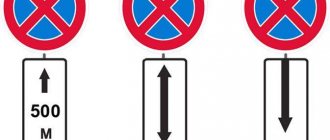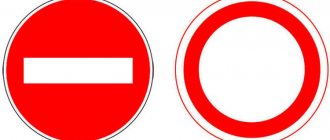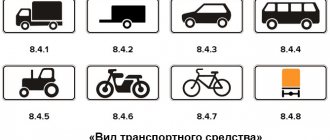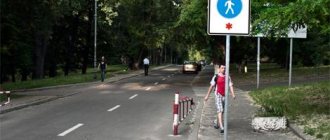Description and history
The road sign has a round shape, a blue background with a red border around the circumference and red stripes intersecting at an angle of 90 degrees - a kind of cross. Thanks to this coloring (valid since 2013), the sign is clearly visible even from afar.
In its familiar form today, this road definition appeared in 1973 after the introduction of the standard on the territory of the Soviet Union. Before this event, the specified road sign was decorated in yellow colors. The rules have been and continue to be regularly amended, but after 2013 they have not yet addressed issues related to this sign. But the size of fines (administrative liability), to the chagrin of those who are not friends with the law, has increased significantly since 2013.
Time and conditions for stopping within the sign's coverage area
Sometimes this road sign is temporary . Either on the accompanying plate below, or on his body itself, the time or periods of validity of the prohibition on stopping are indicated. The time period is indicated in hours and minutes, in days of the week, in Roman numerals - even or odd day of the month, and often - in a combination of times: days, hours and minutes for which the stop ban applies. At any time not indicated on the sign or the sign below it, you can freely drop off passengers within the sign's coverage area.
Related material Tire pressure sensors: TPMS system
Interpretation of a road sign
Sometimes motorists are annoyed when they see that stopping is prohibited. Nothing is done for nothing, especially in approved traffic rules, including those as amended since 2013. This means that on these sections of the road, a stopped vehicle can become a serious obstacle, creating emergency situations when drivers of other vehicles will be forced to break the rules when passing (for example, in areas with busy traffic, on too narrow roads, if there is a sharp turn ahead).
In places indicated by this sign, not only stopping, but also parking (or parking) of vehicles is prohibited.
In more detail, before or behind the sign it is prohibited:
- a planned stop of a vehicle for a duration longer than that required for exiting or boarding passengers, loading or unloading cargo, and, of course, parking or parking;
- any previously planned stop lasting more than 5 minutes.
In this case, a forced stop or parking is possible if the vehicle breaks down or the driver feels unwell, as well as for other similar reasons. In this case, the driver must turn on the hazard warning lights. You will also need to post an emergency stop sign on the road. If all these conditions are met, traffic police officers will not record a violation.
An exception is also provided for stopping route vehicles. These categories of road users are allowed to stop in places specially designated for them to stop, but not in front of them.
At the same time, there is no provision for imposing a fine for stopping cars driven by disabled people if the sign is supplemented with the appropriate plate (8.18) - a wheelchair is graphically displayed, crossed out with a red line.
Also, the driver should not pay attention to the installed road sign prohibiting stopping if a representative of the traffic police slows him down - this will not constitute a violation. So, he is obliged to stop at the place indicated to him by the traffic policeman or traffic police inspector.
How does the “No Stopping” sign work?
This sign confirms that not only a temporary “pit stop” is prohibited, including for boarding and disembarking passengers or loading and unloading cargo, but also parking at the place of its operation. In the future, we will keep in mind that stopping and parking in the area covered by this sign is prohibited.
Explanations of the difference between a stop and a parking lot are posted in the descriptive part of the road sign “Stopping is prohibited” of the traffic rules. Therefore, some drivers with weak logic often, having parked the car under a sign prohibiting stopping, try to argue that they are right by the fact that they are going to stand here for no more than five minutes or they need to load and unload or get in and out in the zone of its coverage. Have you encountered a problem that cannot be resolved without legal assistance? Qualified lawyers are ready to defend you! By entrusting them with full or partial management of the case, you will significantly increase the chances of a positive outcome. Free legal advice at Advokatorg.ru will help you. All these actions fall under the concept of “stop,” which is prohibited by this sign. Such inattention contributes to additional financing of the state budget at the expense of your personal funds.
The “No Stopping” road sign is quite interesting from the point of view of:
- selectivity of its actions to various types of vehicles;
- zones of its action;
- time and conditions of stopping in the area of the sign;
- differences in measures and forms of punishment for drivers who violate traffic rules.
Related material How long is a medical driver's license valid?
In this regard, there is no direct unambiguous answer to the question: is it possible to drop off a passenger “with impunity” in the area covered by the “No Stopping” sign? Now we will consider in detail possible situations depending on these factors.
Zone where the traffic sign is valid
The territory covered by the prohibitory action of the road sign extends to:
- intersection (this does not include a break in the dividing line, exits from courtyards in populated areas, as well as the exit of a small forest or field road);
- the place where the settlement ends (if there is no road intersection before the corresponding designation);
- a road sign has been installed that cancels all previously existing restrictions (3.31).
One more nuance: stopping (parking) is prohibited only on the side of the road where the sign is posted. For example, if on one side of the road (for example, on the right) with a one-way direction of movement, the driver paid attention to the “stopping is prohibited” sign, then this will not prevent him from stopping on its left side in an acceptable place. Parking here is not regarded as a violation and does not entail penalties.
Fines for stopping under a no-stop sign
Many novice drivers often confuse this sign with a very similar one - “parking prohibited”. In this case, the confusion is caused by two criteria:
- Visual – on the “no parking” sign there is only one diagonal red line, and the road. zn. stopping is prohibited with two lines;
- Legal - while in the first option stopping and parking is prohibited, under the sign parking is prohibited you cannot only park the car, but stopping is allowed.
How long can you stand when stopping and parking? The Traffic Rules establish that these are two completely different concepts. The difference lies in how many minutes are given to stop. A stop is considered to be the placement of a vehicle for no more than 5 minutes. Parking – long-term placement of a vehicle with the engine turned off for more than 5 minutes.
Verbally, the sign driving without stopping is prohibited has a similar name. But these are completely different things that should not be confused, especially for people who are just going to take the theoretical exam at the traffic police. It belongs to a completely different section - “priority signs”, and visually it cannot be confused with others. It looks like a large 8-sided red polygon with the word “STOP” in the center. But his demand is completely opposite - all cars stop near him, because driving without a complete stop is prohibited.
Signs 3.27 and 3.28 may not be valid all the time, but only on certain days or hours. For example, a blue no-parking circle with a white Roman numeral "1" through a line means that parking is prohibited only on odd days of the month (3.29). And two crossed out sticks on a blue background (3.30), on the contrary, indicate that parking is prohibited on even days.
They are always there. Let's consider several situations when disembarking and stopping passengers is allowed without any restrictions. That is, the validity period does not apply to them.
- In the case of 3.27, the sign does not apply to route vehicles. They may stop, but only if there are appropriate signs and places to stop. Minibuses must stop strictly behind the sign, and not in front of it.
- Exceptions include disabled people, that is, drivers of vehicles that have the appropriate sign. But such permission applies to those sections of the road where, in addition to 3.27, there is a sign 8.18. It complements the sign and depicts a wheelchair crossed out with a red line. Many people think that it is supposedly prohibited for disabled people to stop here. In fact, the sign with the sign is interpreted as stopping is prohibited for everyone except the disabled.
- Another situation. The driver is driving in the area of a stop sign and is stopped by a police officer. Does the sign prohibit you from stopping in such a situation? No. If the police require you to stop and this happens in the area of this sign, such a stop will not be considered a violation. It is better to comply with the requirements of the inspector or regulator.
The sign is valid for the following zones and territories:
- intersections (this does not include lane breaks on the road, exits from yards and exits of forest and field roads);
- places where a populated area ends and there is no road intersection;
- to another road sign, which removes previously relevant restrictions (we are talking about sign 3.31).
Again these adjustments. Yes, I would like to just put up one simple and understandable sign that every driver could easily navigate by.
In some places, the traffic rules actually have too many nuances, which cause confusion and confusion. But what can you do, these are the rules. All we, drivers, have to do is follow them.
Nuances of the sign's action
The coverage area of road signs can be indicated by using signs together with a sign. So, if there is a sign 8.2.3 under the sign (an arrow that goes down), then this means that stopping before it is prohibited. If these signs are violated, a fine will be imposed on the driver who stopped immediately in front of these signs. But at the same time, stopping directly behind the sign is not prohibited and is not regarded by inspectors as a violation of the rules.
If there is a sign 8.2.2 under the sign (an arrow going up and digital symbols below it), then this sign indicates the distance within which stops cannot be made. For example, if a sign has a sign (i.e., an additional message with important information is attached underneath it), which shows an up arrow and the number 50 m, then stopping (parking) is prohibited at the specified interval, starting from the installation site.
At the same time, it is not prohibited to stop directly in front of him - accordingly, a fine will not be imposed.
If there is a sign with a double arrow pointing up and down, then this is a reminder to motorists (if the period where the restrictions apply is long) that the ban is still in effect and you cannot stop. That is, parking is prohibited in the place in front of and behind this sign.
Yellow markings along the curb or along the edge of the road (solid line) - 1.4, this determines the coverage area of the sign installed in front of it. This means that stopping and parking are allowed in front of it or after the end of the marking line. If you do not follow the indicated marks, this is automatically equated to a violation of the rules, which means a fine will follow.
The zone in which, according to the sign, stopping is prohibited, can be interrupted if there is a parking lot in this place, which is indicated by the corresponding sign (the name of the sign “Parking” was introduced in 2013).
Limiting the period of the ban by time
Signs 3.27 and 3.28 may not be valid all the time, but only on certain days or hours. For example, a blue no-parking circle with a white Roman numeral "1" through a line means that parking is prohibited only on odd days of the month (3.29). And two crossed out sticks on a blue background (3.30), on the contrary, indicate that parking is prohibited on even days.
Parking or stopping may also be prohibited during the day or night. As a rule, the restriction applies during the day, but at night you can ignore the sign. This is evidenced by a sign underneath it, indicating the time interval during which the ban is valid. So, if under the circle on the sign it says “8:00-20:00”, this means that you cannot leave your car here from eight in the morning to eight in the evening.











